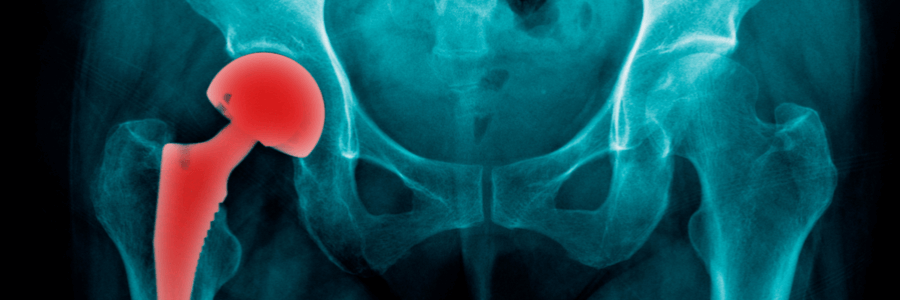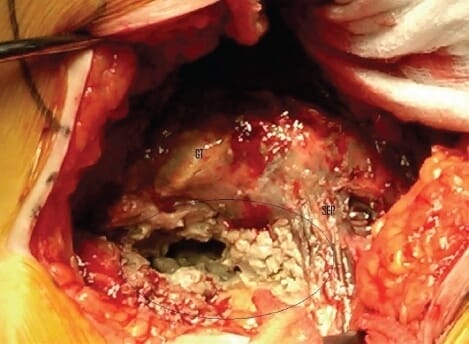
Metallosis from Metal on Metal Hip Replacements
What is Metallosis and How is it Related to Metal Hip Replacements?
It involves a build-up of metal debris in the body’s soft tissue. This happens when parts of metal on metal hip replacement rub together, releasing tiny cobalt and chromium particles into your bloodstream and the tissue surrounding your hip.
These metal particles rot healthy red tissue and muscle around the implant and turn it into a dry, gray, and dead mass of gunk. This means pain and loss of mobility. Sometimes, acronyms like “ALVAL” (Aseptic Lymphocyte-dominated Vasculitis-associated Lesion) or “ARMD” (Adverse Reaction to Metal Debris) are also used to describe similar metal poisoning from MoM hip implants.
Unfortunately, a medical literature discusses how these metal particles get carried through your bloodstream. This potentially causes serious health complications in other body parts and systems, other than just the hip.
Important:
People with metallosis may not have any symptoms at all, but are still at risk of developing health problems from metal poisoning.

You May be at Risk for Metallosis
Many doctors recommend that patients with metal on metal hips have their blood tested every three months for high cobalt and chromium levels. Cobalt and chromium particles are also referred to as “metal ions.”
Generally, higher blood metal ion levels indicate greater implant wear. Medical studies show that the longer you have your implant in place, the higher your risk of experiencing metallosis.
What is Considered a High Metal Blood Ion Level?
A diagnosis of metallosis requires testing a patient’s blood for cobalt and chromium levels. The Mayo Clinic’s Medical Laboratories have stated that chromium levels greater 1 part per billion “suggest significant prosthesis wear.” They also report that “toxic concentrations” of cobalt are “greater than or equal to” 5 parts per billion.
TOXIC LEVELS OF CHROMIUM IN THE BLOOD = GREATER THAN 1 PART PER BILLION (PPB)
Hip Revision Surgery – Preserving Evidence for your Case
If you have higher than normal metal levels in your blood, or other complications, your surgeon will probably recommend hip revision surgery. This is a second hip operation to remove and replace parts of your metal on metal hip with a different type of implant.
It’s very important to contact our attorneys before your revision surgery so we can try to preserve evidence for your case. This includes getting images of the tissue damage during surgery and safely storing the hip parts removed from your body. While not required for your case, many times, this evidence can be very helpful in proving your claims.
Contact us immediately for a case evaluation because there is a time limit to file a claim. Call 888-952-5242, or fill out the form below, or chat with us.

Find out now if you have a defective metal hip injury claim
Your case review is free. Find out how to preserve evidence in your case.
Metallosis: Symptoms of Metal Poisoning

Metallosis causes a number of serious health complications, which are detailed in the section above. However, some people with metallosis also report experiencing the following symptoms:
- Metallic taste in your mouth
- Early morning nausea
- Physical signs of implant failure (popping, squeaking or pain in the hip)
- Shortness of breath
- Ringing in your ears or hearing loss
- Depression and anxiety
- Blurry vision
- Headaches
If you are experiencing any of these symptoms, you should talk to your doctor immediately about your metal on metal hip. Ask for a blood test to check your metal ion levels for metallosis. With that being said, it is important to remember that many patients with metallosis exhibit no symptoms, so you should still have your metal ion levels tested regularly to make sure that your implant is not failing.
Is Metallosis Treatable?
Having a hip revision surgery should decrease the metal particles being released into your blood and allow your metal ion counts to lower back to normal levels. Revision surgery is a second operation where the surgeon removes the defective metal on metal hip and replaces it with a different type of hip implant.
What are the Health Problems Caused by Metallosis?
Often, metallosis is only detected AFTER a patient has already started experiencing severe health problems, such as vision loss or heart disease. In these cases, patients go to their doctors to resolve a problem that is seemingly unrelated to their hip implant only to discover that metallosis from their hip implant is the underlying cause.
Brands of Hip Cases Our Attorneys are Currently Reviewing
If you have one of the hips implants listed, contact us immediately because there are time limits to file a claim. We are NOT reviewing any metal on polyethylene or ceramic type hip implant cases other than the Stryker LFit V40.
Metal Hips Complications

Click Here To See a List of Revision Surgeons Listed by State
Frequently Asked Questions about Metallosis
What is Metallosis?
Metallosis is a build-up of metal particles in the body’s soft tissue. These particles rot healthy red tissue and muscle around the implant and turn it into a dry, gray, and dead mass of gunk. Metallosis leads to pain and a lack of mobility.
How Do You Get Metallosis?
You can get metallosis from a metal on metal hip implant. When the metal parts of a hip replacement rub together they release tiny cobalt and chromium particles into your body. These particles then eat away at healthy muscle, tissue and bone in the hip joint. The metal particles can also travel through your bloodstream and damage other organs throughout your body.
How is Metallosis Treated?
The only treatment for metallosis from a hip replacement is to remove and replace the metal parts so they no longer rub together. This process involves surgery to saw off parts of the hip implant and replace them with non-metal parts. Your surgeon may also have to clean up the damaged tissue and muscle around the hip joint.
How Serious is Metallosis?
Metallosis is a very serious complication that can lead to many widespread health impacts or even death. Systemic impacts to the body like heart disease, hearing loss, and vision loss are possible results of metallosis.
What are the Complications of Metallosis
Complications of metallosis from a defective metal on metal hip replacement include:
- Metallic taste in your mouth
- Early morning nausea
- Physical signs of implant failure (popping, squeaking or pain in the hip)
- Shortness of breath
- Ringing in your ears or hearing loss
- Depression and anxiety
- Blurry vision
- Headaches
- Heart disease
In addition, since the only way to treat metallosis is by removing the damaged metal, a common complication is the need for revision surgery to debride damaged tissue and replace the metal on metal implant.
Content Reviewed by Michael Cowgill – Medical Product Liability Lawyer

Michael Cowgill is an experienced attorney in the medical product liability division at mctlaw. Michael focuses his practice on defective medical devices such as recalled metal-on-metal hips and wrongful death lawsuits involving Kratom. Mr. Cowgill graduated Magna Cum Laude from Lewis & Clark Law School in Portland, OR. He volunteers as a high school mentor with a program for underprivileged youths interested in pursuing a future legal career.
This page was last updated:


Find out right now if you have a claim
Your case review is free. Don’t wait to get help because it could hurt your case.

As an experienced leader in these types of lawsuits, we were confident the firm would have the expertise. However, what surprised us most was the high level of excellent customer service from the firm’s staff!
Pat R.
I can’t recommend this firm enough. They have an outstanding team that truly care for their clients…I have been awarded a fair six figure settlement.
Nate M.
When I say “they went to bat” for me…this Law Firm literally did just that. They persevered to bring the hard-nosed Manufacturer to settle and provide me some recompense for everything I had to endure which led to this suit.
Me’Chelle
